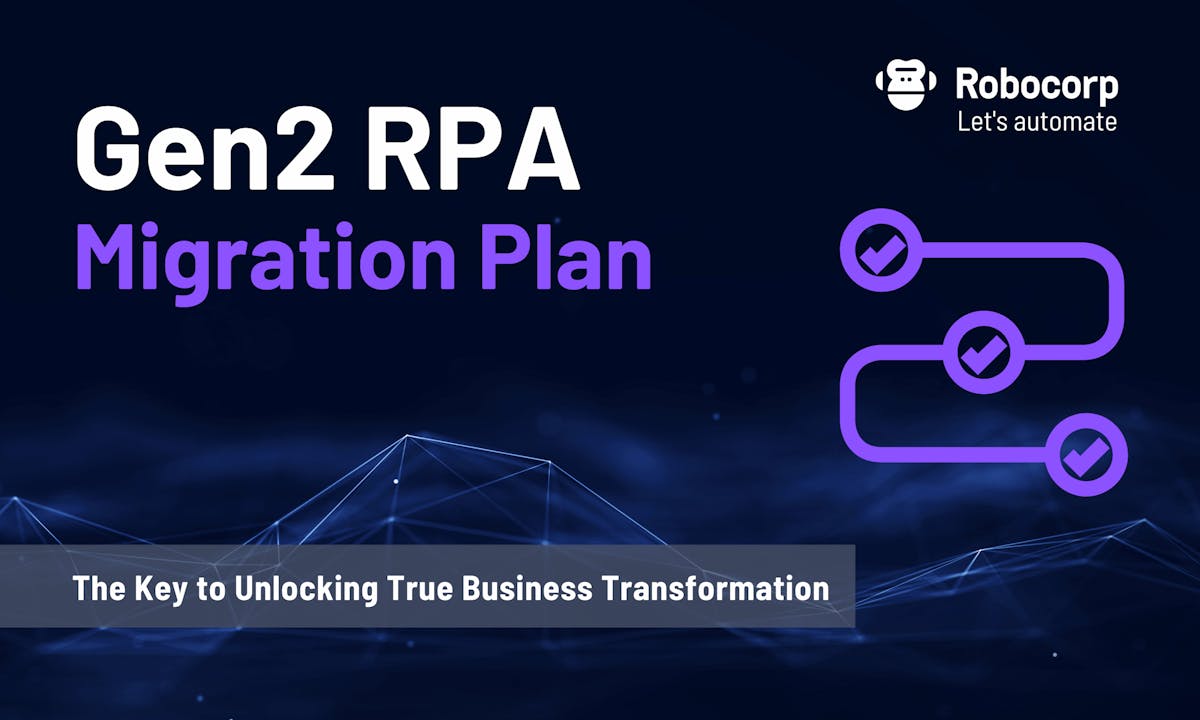
Gen2 RPA Migration Plan: The Key to Unlocking True Business Transformation
Open-source intelligent automation gives enterprises the tools they need to succeed in an AI-driven future while delivering significant ROI today.
April 12, 2023 – Scott Eddleman, Head of Product Marketing
There’s been a quickly moving shift in how organizations function and compete. Recent developments in artificial intelligence, machine learning, and open technology ecosystems create an AI-driven, hyper-competitive environment. As a result, technological advancements will be more frequent, markets will shift more quickly and dramatically, new disruptors will emerge, and economic uncertainty and volatility will impact businesses that aren't prepared.
Gen2 RPA, an advanced form of intelligent automation, is an open-source technology that positions companies to proactively anticipate and respond to challenges while continuously evolving their operations to stay competitive. Gen2 RPA is set to revolutionize how companies innovate and remain ahead of the curve. This article will discuss the value of Gen2 RPA in helping enterprises thrive in the future and offers a road map for the transition to Gen2 RPA, complete with essential deliverables.
Who’s this article for?
The short answer is anyone affected by the benefits and risks of a more autonomous enterprise. Key stakeholders include business, IT, finance, and operations leaders. Centers of excellence, automation teams, and process owners are responsible for managing business processes. Compliance teams will ensure solutions or automated processes comply with relevant laws and regulations. The Gen2 RPA migration plan involves all these different stakeholders.
What’s the difference between Gen1 and Gen2 RPA?
Gen1 RPA, sometimes known as traditional or proprietary RPA, was the first generation of robotic process automation that used screen scraping and UI-level interactions to access business systems, listen for triggers, and execute prescribed actions.
Over time, these Gen1 tools became more sophisticated by interfacing with ERPs, CRMs, and other platforms through APIs and offered pre-built downloadable programs from their bot stores. This extended their functionality and use cases and helped them garner some of the world’s largest brands as customers. But, unfortunately, the bigger they got, the more they defended their expensive pricing models rather than offering innovation and pricing that met their customers’ evolving needs.
This is where open-source Gen2 RPA came in. It’s a leaner, more flexible, scalable, and cost-effective generation of enterprise automation. It offers intelligent automation capabilities, interfaces with virtually any technology - regardless of age or vendor - and automates critical business processes 3x faster, with limitless scale, at ⅓ the cost of Gen1 RPA solutions. In addition, since it’s open-source, companies can use their automations indefinitely without the risk of vendor lock-in.
Gen2 RPA is based on the Python programming language, shared with most AI/ML models, offering convenient, seamless integration. This helps enterprises leverage their existing technology investments while capitalizing on transformative SaaS tools, artificial intelligence, and machine learning. Furthermore, by pairing Gen2 RPA’s AI-assisted automation capabilities with a broader technology ecosystem - it becomes a universal engine of operational execution that can reshape the core foundations of the enterprise.
Should you adopt Gen2 RPA?
One of the significant benefits of Gen2 RPA is that it extends the scale and ability of companies to deliver as much value to as many stakeholders as possible at the lowest cost. In addition, it multiplies the learning capabilities of an enterprise, driving continuous improvement and performance over time.
Gen1 RPA solutions tend to lag in optionality, scale, and AI readiness - and they come with a more expensive pricing model that includes developer tool licenses and per-robot licenses. These solutions also force customers into inflexible infrastructure arrangements that restrict automations with a fixed amount of processing resources, leading to throttled workflows that cause service level (SLA) and potential compliance risks.

Gen2 RPA, on the other hand, is an evolutionary step ahead that offers a simple and affordable pricing model, including flexible tiers and consumption-based rates that allow enterprises to start for free and align costs with growth over time. In addition, Gen2 RPA only charges for computing resources used and scales up and down dynamically, avoiding the risk of processing ceilings and potential compliance issues. Finally, in a Gen2 RPA-powered company, value creation and capture are much more accessible.
Now, if your Gen1 RPA solution can deliver the features your organization needs today and in an AI-driven future, you shouldn’t adopt Gen2 RPA. However, if you need greater interoperability, flexibility, scalability, and more straightforward and cost-effective pricing, then Gen2 RPA is the right path forward.
Multi-vendor RPA strategy
Please know that you don’t need to replace your Gen1 RPA solutions if you don’t want to. One of the top reasons large companies adopt open-source Gen2 RPA is because they ease into it over time. It coexists with your current Gen1 RPA solutions. This approach is attractive for most stakeholders since it doesn’t require strict deliverables and timelines.
Most enterprises convert their Gen1 RPA bots across a 12 to 18-month phased migration plan. Since there are no licensing fees and you only pay for the Gen2 RPA computing resources that you use, your cost directly aligns with your consumption. As you migrate more processes to Gen2 RPA, you can phase out expensive Gen1 RPA licenses and infrastructure costs.
Gen1 RPA to Gen2 RPA Migration Roadmap
The migration from Gen1 RPA to Gen2 RPA is a serious step in unlocking the potential of AI-powered business transformation. Below is a migration roadmap with critical deliverables and items to consider.

First, it is vital to ensure that all relevant stakeholders are involved so communication is open and you can avoid errors. These include IT leaders, heads of RPA centers of excellence (CoE), department leads, business process owners, business analysts, and solutions architects. IT leaders will provide the necessary support and resources for the migration, while the CoE heads will ensure that the migration is aligned with the overall RPA strategy.
Department heads, process owners, and business analysts will provide insights into the business processes that need to be automated and how the migration will impact these processes. The solutions architects will help design the new Gen2 RPA environment and ensure it meets the organization's technical requirements.
- Develop a project plan: Use project management tools like Monday.com or Asana to keep teams and deliverables on track. First, determine the project scope, timeline, budget, and goals. Then, develop a communication plan to keep stakeholders informed of project progress and updates.
- Conduct an assessment: Evaluate your current Gen1 RPA solutions, including their capabilities and limitations. Identify the most critical processes that must be migrated to a Gen2 RPA solution. Examine gaps in features and functionality so you can plan for improvement.
- Write business requirements: Document your current and future RPA needs. Dream big. Gen2 RPA is open-source, so don't restrict the scope, scale, or functionality of your new intelligent automations. Your bots can run in the cloud, on-premise, or both.
- Engage your Gen2 RPA provider: Gain access to low-code and pro-code automation tools and pre-built and open-source Robot Framework libraries and keywords. Take free Gen2 RPA certification courses to onboard newer developers. Connect with your vendor’s customer success team and join their developer community.
- Build Gen2 RPA bots: Take your business requirements and start building. At Robocorp, our customers generally use VS Code as their go-to integrated development environment (IDE). We also offer a free code-native, low-code tool called Automation Studio. In addition, Robocorp offers Gen1 bot conversion tooling that helps you convert existing BluePrism, Automation Anywhere, and UiPath bots. It's available in Automation Studio and as a VS Code extension. Gen2 RPA uses Automation Ops best practices for continuous integration /deployment using GitHub, which enhances governance and compliance. Most Gen1 RPA providers do not offer this level of control.
- Test and validate: Test your new automations to ensure they work as expected. Make sure they meet your requirements and the expectations of your stakeholders. Address any issues that are discovered during testing and validation.
- Migrate: Start a pilot project to familiarize yourself with the technology. Then, roll out your bots to other processes and departments in a phased approach. As mentioned earlier, many large enterprises use a multi-vendor strategy for the first 12 to 18 months. This gives them time to migrate to Gen2 RPA more stably.
- Maintain and support: Continuously monitor the performance of your Gen2 bots and make any necessary adjustments. In addition, provide ongoing support and maintenance to ensure the solution continues to meet your enterprise needs. A great thing about Gen2 RPA is that you can run your bots indefinitely without the risk of a vendor forking the code or forcing you into messy product upgrades.
Wrap-up
Migrating from legacy Gen1 RPA to Gen2 RPA is a strategic move for companies seeking to unlock the full potential of AI-powered business transformation. By implementing a well-thought-out migration plan, companies can fully capture the benefits of Gen2 RPA’s enhanced automation performance, reduced costs, and expanded scale and learning capabilities.

Compared to Gen1 RPA solutions, Gen2 RPA offers a more flexible and affordable pricing model that aligns costs with business growth over time. In addition, Gen2 RPA provides dynamic scalability, meaning enterprises can use only the computing resources they need at a given time, eliminating the risk of processing ceilings and compliance issues.
Gen2 RPA can be a game-changer for enterprises needing to remain competitive in the rapidly evolving business landscape. By adopting a well-planned migration plan, companies can leverage the benefits of Gen2 RPA to drive successful business transformation and stay ahead of the curve in the age of AI.
About Robocorp
Robocorp is the industry leader in Gen2 RPA. Many of our customers see 3x - 10x gains in their RPA ROI compared to their experience with other automation solutions. We look forward to showing you the flexibility and dependability of open-source Gen2 RPA to automate your most complex enterprise business processes - at a fraction of the cost of traditional RPA solutions.
Check out our case studies to see how other companies have transformed their businesses with Gen2 RPA. But, of course, we have other customers, too, and we’d love to share their stories and introduce you to them if you’d like.
Robocorp is the leader in open-source Gen2 RPA - with hundreds of customers - from Fortune 500 enterprises to start-ups - that are augmenting or replacing UiPath, Blue Prism, Automation Anywhere - or simply want to start their automation journey with a more modern platform.
Visit https://robocorp.com/talk-to-sales to learn more.